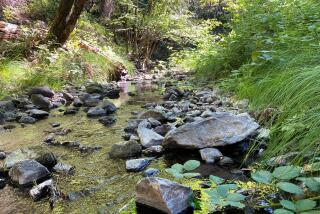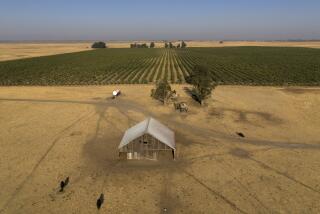Marin Reconsidering Its Water Policy : Planning: The county has kept supplies scarce in order to slow development. But in the wake of the drought, some residents say it is time to find new sources.
MILL VALLEY, Calif. — Ah, Marin. Wide-open spaces, towering redwoods, hillside hot tubs, gourmet restaurants. There is little, Marinites will happily tell you, that their splendid county lacks.
Except water.
Until torrential March rains bailed them out, residents of this peninsula across the Golden Gate Bridge from San Francisco were enduring the strictest water rationing rules in California--a paltry 50 gallons a person each day. Prized gardens appeared doomed, showers became a luxury and Laundromats and paper plates were suddenly chic.
This sort of inconvenience--which could easily return if the drought lasts a sixth year--seems incongruous in a place as affluent as Marin. But it is a predicament that the county has only itself to blame.
Worried that boosting available water supplies would spur growth, Marin voters had overwhelmingly rejected efforts to supplement local reservoirs by importing water from a river to the north. As a result, the county faces a water shortage and is scrambling to find new sources lest the drought bite again in 1992.
Making water scarce has clearly helped Marin keep growth at a snail’s pace. While most of the Bay Area was booming in the 1980s, Marin’s population inched up just 3%--the third-slowest growth of any county in California. A ban on hookups to the water district is in its third year and has stalled more than 100 residential and commercial projects.
Some Marinites believe brown lawns and other rationing-related inconveniences are a price worth paying to keep the dreaded developers out. But others--including leaders of past campaigns against imported water--are fed up and now question the wisdom of earlier policies.
“We’ve been through two devastating droughts now, and many of us are tired of not flushing our toilets and watching the garden die,” said Michael Wornum, a former county supervisor who once fought a ballot proposal to pipe in Russian River water from neighboring Sonoma County. “Our idea was to use water--infrastructure--to control growth, but we found it to be a blunt instrument. What that approach does, we’ve learned, is hurt the quality of life of the people who live here.”
Elected officials have broader complaints. They are grappling with a host of problems blamed on Marin’s slow growth rate, including a lack of affordable housing and thick traffic caused by county workers who commute from areas where homes are plentiful and priced within reach.
Some leaders also acknowledge a nagging discomfort with the increasing exclusiveness of Marin, where the median price of a single-family home was $360,000 last year and the average household income--$62,700--is well above that of the other eight Bay Area counties. These officials lament Marin’s graying population and its image among many outsiders as a haven for the rich and the self-indulgent.
“Marin is a very special place, with incredible natural beauty . . . and that needs to be protected,” said county Supervisor Al Aramburu, an East Los Angeles native who moved north 22 years ago. “But from a social standpoint, the question is what’s fair? Do we (restrict growth) to the exclusion of all but the very wealthy? To the exclusion of our sons and daughters? Are we protecting the environment or are we just discriminating against people?”
Conservationists share such concerns, and many point out that they could never afford homes in Marin at today’s staggering prices. On the other hand, they argue that the county’s spectacular natural resources are a treasure enjoyed not only by locals but by millions of visitors. Releasing the brakes on development, they argue, would threaten Marin’s rare features while doing little to remedy traffic and housing woes.
“We’re really a big back yard for the Bay Area and the rest of the state,” said Karin Urquhart, executive director of the politically muscular Marin Conservation League. “So it’s not just that we’re stopping growth. We’re really preserving what we are able to give to the rest of the world.”
Marin, lampooned by author Cyra McFadden in her 1977 book “The Serial” for its hot-tub culture and laid-back lifestyle, is one of the most growth-conscious places in California. Its history of land preservation, Urquhart said, dates to the 1930s, when the Golden Gate Bridge was being built. Four women, fearful of the changes Marin’s new link with San Francisco might bring, hired a planner to recommend where development should occur in the county and which properties should be off limits.
Today, much of Marin’s agricultural western flank is protected by zoning that limits building to one house per 60 acres. Urban development has been confined to the 11 cities in an eastern corridor straddling U.S. Highway 101.
Ample open space seems a virtual birthright in Marin, which is home to 233,500. Mt. Tamalpais State Park, Point Reyes National Seashore and Angel Island are part of an impressive array of protected preserves. Counting federal, state and regional parks, as well as other restricted lands, only about 12% of Marin’s 332,000 acres are considered developable, county officials said.
Most of the land that remains up for grabs is the source of controversy.
“The county and virtually all of the towns and cities have very rigorous regulations protecting ridgelines, hillsides, views and so forth,” said Herb Nienstedt, legislative analyst for the Marin Builders Exchange. “It isn’t unusual for a house--one single-family home--to take three years to go through the permit process. People often object simply on the grounds that they can see the structure.”
Marinites added control of the water supply to their list of strategies for keeping the bulldozers at bay over the past decades. The premier battle was in 1971, when residents were asked to help Sonoma County build a dam that would have provided Marin with 44,000 acre-feet of Russian River water each year--triple its annual demand at the time.
Opponents, including members of the water district board and a movement called “The Plot to Save Marin,” warned that the abundant new supply would bring “Los Angelization” to their county. Those were the magic words; voters defeated a request for bonds to finance the dam by a 9-1 margin.
Six years later, the county was in the clutches of a dreadful drought, with residents limited to 67 gallons a person a day. Things got so bad that Marin was forced to stretch a pipe across the San Rafael-Richmond Bridge--an emergency umbilical cord allowing the county to pump in water from the Sacramento-San Joaquin Delta that had been freed up by Southern California.
The misery of rationing returned to Marin this year. With its seven reservoirs near record-low levels, the water district’s board directed customers to get by on just 50 gallons a day--an amount, one resident grumbled, “that makes life in Marin almost uncivilized.”
The drenching March rains persuaded the water district to replace rationing with a voluntary conservation program, but residents have not forgotten the inconveniences they were enduring a few months ago.
In a recent poll by Marin’s daily newspaper, the Independent Journal, 87% of those surveyed urged the district to find more water, and a majority gave the agency poor marks for its performance.
Among those most critical of the district are people snared by its moratorium on hookups. There are a few large-scale developers on the waiting list, but a church, a hardware store and many families seeking to build homes for themselves also have been held up.
Take Warren Outten of Novato, who wants to build a retirement house for himself and his wife on a lot he bought in Tiburon in 1972. Outten has been stalled by moratoriums twice before, prompting him to redesign his house, and now it has happened again.
“It’s extremely frustrating, not to mention expensive, because we’ve got the land, the plans and everything we need but we can’t go ahead until we get the water,” Outten said. Like others on the list, Outten blames his quandary on the water district’s “deliberate attempt to control growth.”
“They have taken it upon themselves to act as a sort of superior planning commission, and we’re paying the price for that now. I think water districts should provide water. They haven’t.”
Experts say that one jurisdiction’s use of water supply to control development--a strategy also employed successfully in Goleta, north of Santa Barbara--can create negative ripple effects throughout the region.
“When community A has no water, and consequently no growth, then everyone moves next door to community B, and what you have is a horrendous transportation problem,” Joseph Bodovitz, project manager of the San Francisco-based Bay Vision 2000, said of the situation plaguing Marin and Sonoma counties. “It seems like a nutty way to handle regional development.”
Residents of Sonoma County--the scene of rapid residential growth of late--could not agree more. Pete Golis, editorial director of the Santa Rosa Press Democrat, summed up the feeling in a February column:
“In the name of environmentalism, Marin County has devised a no-growth policy that systematically denied housing opportunities to working people, young families and minorities. . . . And then Marinites sneered at Sonoma County for permitting the construction of homes.”
When the freeways became crowded, Golis said, Marinites “opposed the construction of additional lanes, arguing instead that Sonoma County commuters should ride the bus, so that there was more room for hometown BMWs.”
This position was dubbed “the Soweto strategy” by one Sonoma County supervisor. “Marin didn’t mind having people around to do the work during the day,” Golis said, “but those people should be bused back to where they came from at night.”
Such talk is greatly distressing to many Marinites, among them, Aramburu. He believes Marin must “remedy this fundamental unfairness” that has placed living in the county out of the grasp of all but the very affluent.
“Our police, our public sector people--they can’t afford to live here,” Aramburu said. “The person who cuts my hair can’t afford to live here. There’s something not right about that.”
Although the March downpour doubled the supply in Marin’s reservoirs, officials realize that the relief could be temporary. Consequently, they are hurriedly studying new sources of water, among them a $120-million desalination plant and a $110-million pipeline link with Sonoma County.
Many experts believe that Marinites--weary after two severe droughts--may approve the importation of water from Sonoma. Others are not so sure. They cite the newspaper poll as cause for their skepticism.
Although it reflected a public desperate for new water supplies, the survey also discovered this: 63% of those polled said water is an appropriate tool to limit growth.
“People want more water,” Aramburu said, “but they won’t vote for it if they believe it will get the developers more units. They’d rather suffer.”
More to Read
Sign up for Essential California
The most important California stories and recommendations in your inbox every morning.
You may occasionally receive promotional content from the Los Angeles Times.










